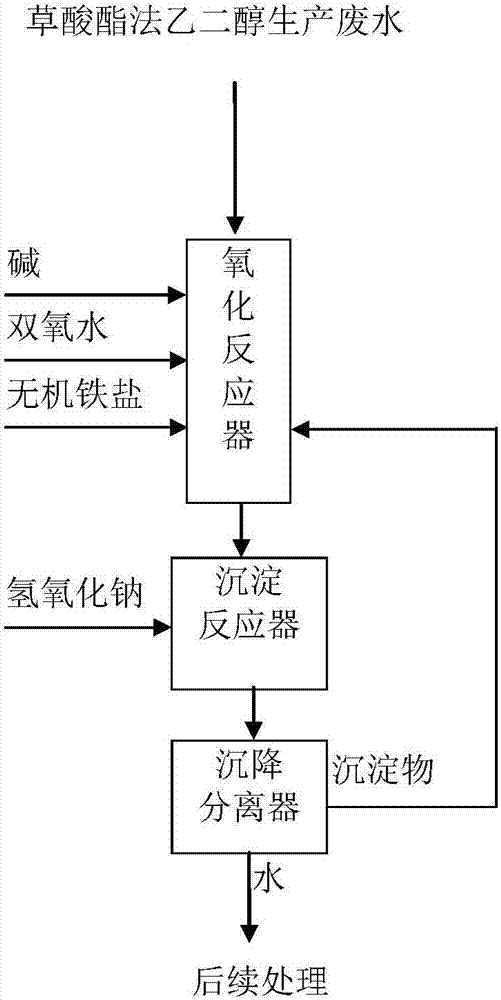Ethylene glycol production wastewater treatment method
A technology for producing waste water and treatment methods, applied in water/sewage treatment, neutralized water/sewage treatment, multi-stage water/sewage treatment, etc., to achieve the effects of reducing pressure and improving biochemical properties
- Summary
- Abstract
- Description
- Claims
- Application Information
AI Technical Summary
Problems solved by technology
Method used
Image
Examples
Embodiment 1
[0037] A company’s oxalate method ethylene glycol production wastewater has a pH value of 1.0, a COD of 20,000 mg / L, and a TOC of 5,000 mg / L. 1,4-dioxane content 7000mg / L. Wastewater B / C was 0.014.
[0038] Carry out catalytic oxidation treatment to this waste water, the temperature control of catalytic oxidation reaction system is 90 ℃, pressure is normal pressure, pH is adjusted to 2.8 with alkali (sodium hydroxide solution or sodium carbonate solution or sodium bicarbonate solution), and total iron content is The dosage of 200mg / L, 27.5% hydrogen peroxide is 80ml per L of waste water (water from the stripping tower), and the reaction time is controlled to 60min.
[0039] Next, react for 20 minutes under the condition that the temperature of the wastewater is 90° C. and the pH of the wastewater is adjusted to 7.0 with 30% NaOH solution.
[0040] Next, gravity sedimentation separation was carried out under the condition that the temperature of the wastewater was 80° C., and...
Embodiment 2
[0043] A company’s oxalate method ethylene glycol production wastewater has a pH value of 1.0, a COD of 20,000 mg / L, and a TOC of 5,000 mg / L. 1,4-dioxane content 7000mg / L. Wastewater B / C was 0.014.
[0044] Carry out catalytic oxidation treatment to this waste water, the temperature control of catalytic oxidation reaction system is 80 ℃, pressure is normal pressure, pH is adjusted to 4.5 with alkali (sodium hydroxide solution or sodium carbonate solution or sodium bicarbonate solution), and total iron content is The amount of 50mg / L, 27.5% hydrogen peroxide is added according to 60ml per L of waste water (water from the stripping tower), and the reaction time is controlled to 10min.
[0045] Next, react for 5 minutes under the condition that the temperature of the wastewater is 80° C. and the pH of the wastewater is adjusted to 6.0 with NaOH solution.
[0046] Next, gravity sedimentation separation is carried out under the condition that the temperature of the wastewater is ...
Embodiment 3
[0049] A company’s oxalate method ethylene glycol production wastewater has a pH value of 1.0, a COD of 20,000 mg / L, and a TOC of 5,000 mg / L. 1,4-dioxane content 7000mg / L. Wastewater B / C was 0.014.
[0050] Carry out catalytic oxidation treatment to this waste water, the temperature control of catalytic oxidation reaction system is 99 ℃, pressure is normal pressure, pH is adjusted to 2.0 with alkali (sodium hydroxide solution or sodium carbonate solution or sodium bicarbonate solution), and total iron content is The amount of 400mg / L, 27.5% hydrogen peroxide is added according to 100ml per L of waste water (water from the stripping tower), and the reaction time is controlled to 90min.
[0051] Next, react for 30 minutes under the condition that the temperature of the wastewater is 99° C. and the pH of the wastewater is adjusted to 9.0 with NaOH solution.
[0052] Next, gravity sedimentation separation is carried out under the condition that the temperature of the wastewater ...
PUM
 Login to View More
Login to View More Abstract
Description
Claims
Application Information
 Login to View More
Login to View More - R&D
- Intellectual Property
- Life Sciences
- Materials
- Tech Scout
- Unparalleled Data Quality
- Higher Quality Content
- 60% Fewer Hallucinations
Browse by: Latest US Patents, China's latest patents, Technical Efficacy Thesaurus, Application Domain, Technology Topic, Popular Technical Reports.
© 2025 PatSnap. All rights reserved.Legal|Privacy policy|Modern Slavery Act Transparency Statement|Sitemap|About US| Contact US: help@patsnap.com

